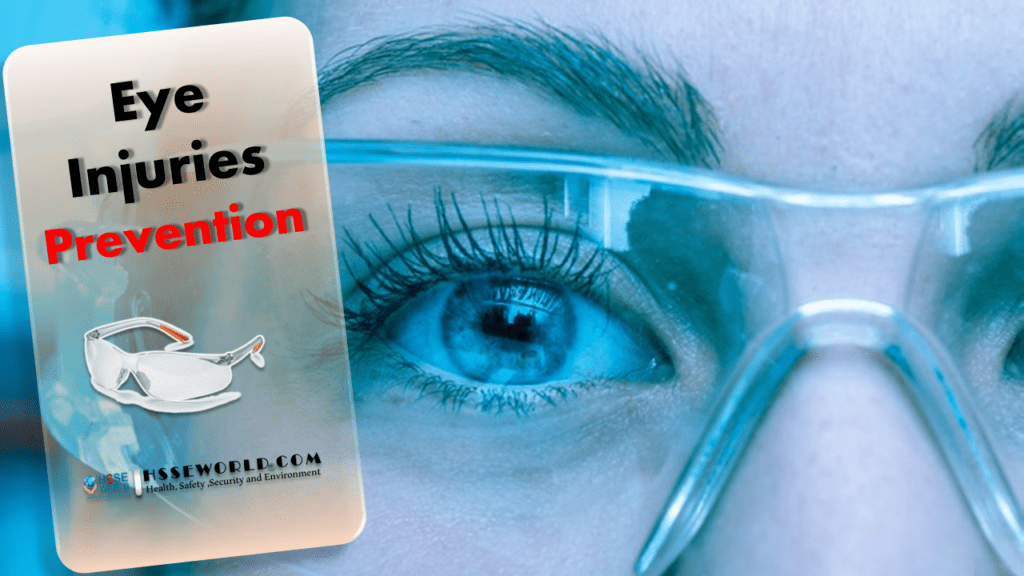Job-related eye injuries can cost employees the use of their sight. According to the Occupational Safety and Health Administration (OSHA), these injuries can also cost employers and insurance companies millions of dollars a year in medical expenses, workers’ compensation costs, wages, and productivity losses. Eye hazards occur in almost every industry. However, the Bureau of Labor Statistics data shows that most eye injuries occur in manufacturing, construction, trade, production, and service occupations. Many workplace eye injuries that require medical treatment result from employees who do not wear eye protection or wear the wrong type for the job. OSHA’s standard 29 CFR 1910.133 requires employers to provide employees with appropriate eye and face protection whenever needed to protect against mechanical, chemical, environmental, or radiological irritants and hazards.
Also Read: Eye Protection’s 10 Key Facts

What can cause eye injuries at work?
Flying objects.
Many injuries result from flying or falling particles, sparks, or larger objects striking or scraping the eye. These materials are often ejected by tools, blown by the wind, or fall from above. Dust, cement or wood chips, metal slivers, nails, and staples are common culprits.
Objects swinging from a fixed or attached position.
Tree limbs, ropes, chains, or tools can be pulled into the eye while the employee uses or holds them.
Contact with cleaning products and other industrial chemicals.
In addition to potential damage from contact with acids, fuels, solvents, cement powder, or other chemicals, the pain from the contact may cause a person to close his or her eyes, trapping the irritant and possibly causing more damage.
Exposure to ultraviolet light.
Welder’s arc, for example, can cause thermal burns that damage eyes and surrounding tissue.
How can eye injuries be prevented in the workplace?
Assess.
Inspect and identify all work areas, access routes, operations, and equipment for potential hazards to eyes from impact, heat, chemicals, dust, glare, or optical radiation. Review past eye damage incidents and injury reports.
Test.
Uncorrected vision problems can cause incidents. Specify the vision abilities required for each job or task. If the employer performs routine employee physical exams, provide vision testing as well. If the employer does not provide vision testing, encourage employees to undergo testing regularly.
Protect.
OSHA standards require that employers provide employees with protective eyewear suited to a specific duty or hazard. No one-size-fits-all standard fits every industry, so safety managers must determine what types of safety gear to purchase. For example, when a hazard from flying objects exists in the workplace, OSHA requires that employers ensure employees use eye protectors with side protection. Detachable side protectors with clip-on or slide-on shields that meet the requirements are acceptable.
- OSHA also mandates that any protective eye and face equipment have a distinct mark to identify the manufacturer. Further, safety glasses and goggles should be certified by American National Standards Institute (ANSI) Z87.1 for industrial eye protection, with the ‘Z87’ mark showing on frames and lenses.
- In certain industries, employees must wear a face shield and goggles to protect against chemical splashes, welding light, and electrical arcs. OSHA requires employers to ensure that affected employees use equipment with filter lenses that have a shade number appropriate for the work for protection from harmful light radiation. Visit osha.gov for a list of appropriate shade numbers for a variety of operations.
Also Read: Protect Workers’ Vision with a Holistic View of Eye Safety
Participate.
Create a mandatory program for eye protection in all workplace operation areas. A broad program prevents more injuries and is easier to enforce than one that limits eye protection to specific departments, areas, or jobs.
Fit.
For goggles, safety glasses, face shields, full-face respirators, or a combination of these worn together to be effective, they must fit workers well. Injury can result from objects or chemicals going around or under the protector. Eye protectors should also allow air to circulate between the eye and the lens.

- Get eyewear fitted by an eye-care professional to ensure effectiveness and comfort. Provide free eyewear repairs and require each worker to be in charge of his or her gear. Properly maintaining eye protectors is also vital because scratched or dirty devices can reduce vision, cause glare, and contribute to incidents.
- For employees who wear prescription lenses while engaged in operations involving eye hazards, OSHA requires eye protection that incorporates the prescription in its design, or eye protection that can be worn over the prescription lenses without disturbing the proper position of the prescription or protective lenses.
Also Read: Night Blindness Facts(Opens in a new browser tab)
Plan for an emergency.
Set up first-aid procedures for eye injuries. Place eyewash stations where they are easy to reach, especially where chemicals are used. Train employees in basic first aid, identify those with more advanced training, and ask them to accept more responsibility in administering first aid.
Educate.
Conduct ongoing educational programs for using protective eyewear. Add eye safety to your regular employee training programs and new-employee orientations.
Support.
Successful eye-safety programs need management support. One way management can show support is by always wearing protective eyewear when needed.
Review.
Review and update the company’s incident-prevention policies regularly.
Put it in writing.
Once the safety program is created, put it in writing. Display a copy of the policy in work areas and where employees gather.
Also Read: The 5 Main Hazards to the Eyes and Face
For more safety Resources Please Visit Safetybagresources




